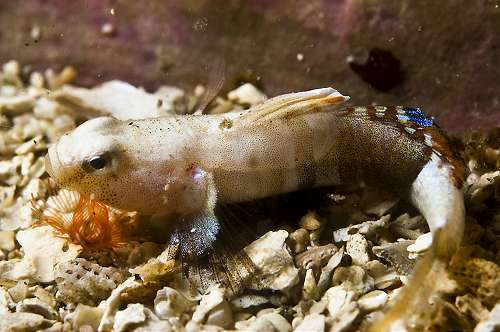Smallest marine fish in Europe discovered in Shetland waters

Europe’s smallest marine fish has been found off the coast at Lunna by two local divers.
The Guillet’s goby (Lebetus guilleti) only grows up to a maximum length of 24mm and was spotted by independent marine biologists Rachel Hope and Richard Shucksmith while shore diving.
It is an extremely rare fish and was only described as a species in 1971. There are only a handful of sightings around Europe including four in England and other sparse records are from the Mediterranean, northern Spain and one from the Kattegat (previously the most northerly record).
This species has never been recorded in Scotland and this finding extends the known range 140 miles further north.
“Due to its rarity it was in none of the ID guides so with the help of fellow scientists it was eventually identified as this rare fish,” said Dr Shucksmith.
The scientists included Dr Lin Baldock, a goby expert, Dr Frances Dipper and Paul Kay who have authored guides to UK fish species, and Dr Marcelo Kovacic of the Natural History Museum at Rijeka in Croatia who found the Guillet’s goby in the Adriatic Sea.
Due to the importance of this sighting it has been accepted for publication in the Marine Biological Association journal Marine Biodiversity Records.
Ms Hope, a keen diver who undertakes surveys of marine life around Scotland for the Marine Conservation Society “Seasearch” programme, said: “Although we had been photographing the marine life around Shetland with the aim of looking for the interesting, rare and unusual species that live around the Shetland coastline we didn’t expect to find a fish quite as rare as this.
“We are very excited to have found such an unusual and rare fish in Shetland. We have both been diving for over 10 years and have thousands of dives between us and had never seen this fish before. We realised we had found something unusual when we examined our photographs and realised this fish was not mentioned in any of our marine life identification guides.”
Little is currently known about the Guillet’s goby’s biology. It seems to prefer living on rough ground such as shelly sand in shallow coastal waters and due to its small size it is able to hide between the shell fragments, making it extremely difficult to spot.
Male and females have different colouration (sexual dimorphism), although both have mottled buff coloured bodies. However, the male has a brightly coloured second dorsal fin with a blue spot and orange stripes, much like a brightly coloured butterfly.
Gobies are a family of small mostly bottom living fish and share a similar small and elongated body shape. They all have distinctive thick lips and bulbous eyes set close together near the top of the head.
Males and females are normally found as pairs together with the females appearing to be swollen with eggs. Normally in goby reproduction the male will choose the nest site such as an empty shell, or a crevice where the female will lay the eggs. The male will then guard the eggs until they hatch. The pairs found off Lunna appear to indicate that the species is breeding around Shetland.
By finding the species in Shetland it means that its known range now must encompass the whole of the UK. Divers and scientists surveying around the coast are asked to look out for the small and beautiful fish when diving or sampling over rough sediment types such as shelly sand or maerl.
As more information is collected about this unusual species a clearer picture can be developed about its biology and distribution. It is possible that the spread of the species further north is a climatic range expansion or it could simply be that due its small size and cryptic colouration it has been overlooked.





NO COMMENTS
Add Your Comment